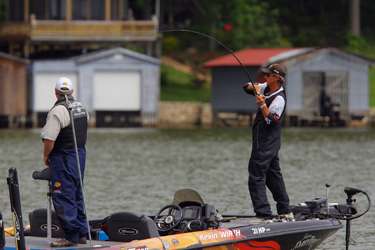
Fall turnover is one of the most common excuses anglers use to explain a bad fall fishing trip. However, unless you are fishing a pond or a small shallow lake, fishermen show their lack of experience or knowledge of the turnover if they use this phenomenon as an excuse for an unproductive day on the water.
Turnover occurs in autumn when the stratified water layers created during the summer start to mix due to cooler temperatures. Prior to the turnover, the surface water is warm and light, while the lower layers are cooler and heavier. The top and bottom layers contain less oxygen than the middle section, so fish tend to hold in the oxygen-rich middle.
"If the lake has any depth at all, all of the water column will not turn over at the same time," says Bassmaster Elite Series pro Kevin Wirth.
"If the water temperature is in the 70s, and all of a sudden you have four or five nights when the air temperature is in the 30s and it drops the upper layer 10 to 15 degrees, the lower layer will come up and the colder water on top will sink (creating the turnover)," says Wirth.
When the turnover occurs, the water quality in the affected area suffers and so do the fish.
"It's an oxygen-depletion scenario, so it's just like when you're starting to choke," Wirth says. "You're more worried about breathing than eating. The fish try to transition through it and tend to scatter and suspend in the water column a lot, which makes it hard to catch them."
Anglers can check for telltale signs to find out if the area they are fishing has turned.
"The water has a greenish-gray look," Wirth says. "It almost looks dead; you don't see anything in it. There will also be a (rotten egg) smell, and you'll start to see a lot of bubbles."
When you find an area that fits this description, you should heed Wirth's next bit of advice.
"You have to avoid it like the plague," he says. "You're just not going to catch fish in those dead waters."
If he's fishing a large lake, Wirth knows the progression of the turnover, which helps him find enough unaffected areas to target. Turnover usually begins in the upper, shallower arms of lakes, which cool down quicker in the fall, and ends on the deeper, lower section where the water stays warmer longer.
"Knowing where it starts and where it heads to is the whole key," says Wirth. "Since turnover usually starts in the backs of the creeks, as soon as you notice that, try to fish the outside of it and go maybe to the mouth of the creek."
The Kentucky pro has also noticed that certain creeks or coves in the same section of the lake turn over at different times, depending on the depth of each creek or cove.
As the turnover moves down lake, Wirth either keeps fishing ahead of the turning water or heads in the opposite direction if he thinks the upper arms have recovered from the malaise.
"As the turnover transitions out, you can transition through it and get behind it," he says.
Wirth estimates it usually takes about two weeks for an area to bounce back from the turnover, but the recovery process shortens if the area gets plenty of wind or current or if a heavy rain flushes out the dead water.
"Once the water starts clearing up a little bit, you can start generating some bites in it," Wirth says.
When he targets these post-turnover waters, Wirth keys on the shallows and throws small-action lures such as spinnerbaits, buzzbaits and crankbaits or pitches to cover with white flipping tubes.
Good times return after the turnover passes through the whole lake because bass have plenty of oxygen throughout the water column.
"Once the turnover completes its chain of events, you can pretty much do whatever you want to catch them," Wirth says.
Originally published November 2011





